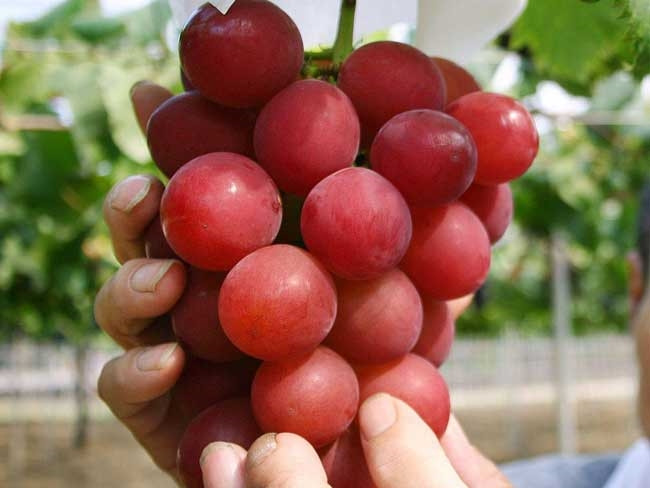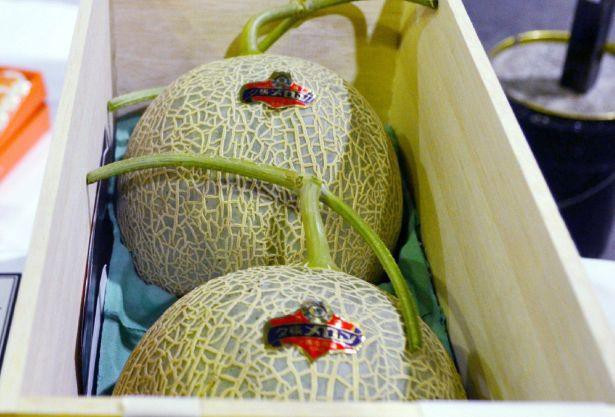Why do some Japanese fruits have super expensive prices?
Japan has long been famous for pursuing perfection in all things so it is not uncommon for this 'obsession' to affect both the fruit and fruit trade.
In Japan there are "heavenly" fruits, there are even expensive cucumbers in a diamond ring. Don't believe it? You can take a walk to check prices with us.
Ruby Roman grapes: 1.1 million yen (US $ 13,000 / kg)

This grape only comes to market when each grape has a minimum weight of 20gr.
Ruby Roman is grown in Ishikawa for over 14 years, the characteristic of this grape is a very large fruit with a very high sugar content (18%) and only brought to market when each grape has a minimum weight of 20gr.
The most expensive Roman Ruby series ever seen was sold in 2016 at the first auction of the year of Kanazawa City Wholesale Market (in Ishikawa Prefecture on Honshu Island) for nearly $ 13,000 for a cluster of 30 fruits (about 430 USD /grape). Mr. Takamaru Konishi - a supermarket owner in Hyogo Prefecture, bought a bunch of grapes to invite his customers to taste for free.
Melon Yubari: 3 million yen (USD 36,000 / fruit)

Do you dare to buy a net melon for $ 36,000?
The first auction of the 2016 harvest season in Sapporo is for a Yubari watermelon pair on Hokkaido Island. They obtained a record price, surpassing the price of 2.5 million yen from 2008 and 2014. This is also the highest price for all kinds of fruits in the world, not just in Phu Tang. Mr. Takamaru Konishi was also the one who bought these two melons, with the desire to thank the Yubari farmers for helping them for many years.
Densuke watermelon: 650,000 yen (7,900 USD / fruit)
Densuke black watermelon is appreciated for its fresh sweetness and its thick fleshed texture. The most expensive Densuke melon was sold in 2008, weighs 7.7kg and costs $ 7,900. An unnamed marine product dealer bought this melon with a desire to help local agriculture grow more.
For Japanese, fruit must be expensive, it is obvious.They regard fruits as gems of agriculture, cherish them as respect for the efforts of farmers. Fruits and fruits also have a precious spiritual meaning, as a symbol of the respect and respect of the people for the gods and children for the births and subordinates to give for their boss, for example.

The most expensive Densuke melon was sold in 2008, weighs 7.7kg and costs $ 7,900.
Amanda Tan, co-founder of Zairyo Singapore, an online grocery store and importer of Japanese products, said: "In Japan, attitudes towards fruits are different from vegetables. Vegetables are real. The product is consumed every day and is a necessity, while the fruit is not so, when they want to spend on an infrequently needed thing, they are meticulous and require great perfection. high ".
To achieve that perfection, the farmer Okuda Nichio has spent 15 years researching and developing the Bijin-hime strawberry (meaning 'beautiful princess') shaped like a cake and is as big as a fruit. tenis. Or as Sato Nishiki cherry has a perfect appearance is like a Christmas ornament. Ruby Roman grapes must also meet the standard of 20g / fruit to be 'shipped'.
The obsession with extremely expensive Japanese fruits comes from Sembikiya, the largest and oldest fruit shop chain in Japan , which was born in 1834. The wife of a samurai, shop owner The fruit of the family has decided to change the business strategy, focusing on the best fruits to buyers to impress their leaders. Gradually, fruit becomes an extremely popular gift.
However, there is no fixed price for these fruits, because they still depend on crops. Therefore, Amanda Tan advises you to buy fruits in the season and if possible, come to the local area to grow specialties so that you can buy them at the most reasonable price.
Some suggestions for you if you want to buy a Japanese fruit gift as a gift:
Sato Nishiki Cherries

Plants are often grown in high-pitched plastic tunnels to protect them from rain (causing the shell to crack).
Do not think that only Americans like cherries, they are not in Japan. Among Japanese cherry varieties, Sato Nishiki is bright red, the light creamy flesh and sweet taste like sugar cane are the most popular.
Eisuke Sato is the name of the 'author' of this type of cherry. Plants are often grown in high-pitched plastic tunnels to protect them from rain (causing the shell to crack). Trees are pollinated and trimmed by hand, only two flower buds and one vegetable bud are allowed on each cluster. When the fruit starts to ripen, farmers will take the leaves around to allow as much exposure to sunlight as possible.
Taiyo no Tamago

Only mangoes with a minimum weight of 350g and a minimum sugar level of 15% are labeled Taiyo no Tamago.
With smooth orange red and oval shape, this mango fits well with the name Taiyo no Tamago, meaning "sun's egg". Mango is a tropical fruit, so farmers in Miyazaki Prefecture have the best opportunity to grow in Japan thanks to strong sunlight and high humidity.
Japanese people started growing mangoes in 1986 but it wasn't until ten years later that ripe mangoes were created but the shells were not rough. The key is to let mangoes fall naturally when they ripen, a net will be placed below to support the mango fruit. Only mangoes with a minimum weight of 350g and a minimum sugar level of 15% are labeled Taiyo no Tamago.
Watermelon has a unique shape

Heart-shaped watermelon.
The first square watermelon was produced by graphic designer Tomoyuki Ono in 1978; because he wanted the melon to be able to fit and neatly in the refrigerator. After that, farmers began to learn the secret and cultivate large square shaped melons to easily stack up when transporting. Tokyo Nishimura high-class fruit shop in Tokyo sells its cubic watermelon for 12 12,960 (158 USD / fruit). Since watermelons simply need to be grown naturally in the available mold, many variations have appeared, including pyramid shaped cucumbers and glue. Hiroichi Kimura farmer from Kumamoto Prefecture has spent three years to produce his heart-shaped melon, ensuring not only beautiful but also delicious.
- The 4 most expensive fruits in the world, one that costs one Mercedes
- Rising vegetable prices increase obesity
- The 10 most expensive supercomputers on the planet
- 10 super expensive fruits in the world
- 12 most expensive vaccines today
- Karlmann King - the world's most expensive SUV
- 6 types of morning fruits are 'medicinal herbs' dinner is 'poison'
- Announcing the cause of Japanese 2011 earthquake super
- Meaning of five fruits in 3 regions culture
- Why are early season food expensive like gold that Japanese people still compete to buy?
- Revealing Chinese fruit
- Is more expensive wine really better?
 Why do potatoes have eyes?
Why do potatoes have eyes? 'Tragedy' the world's largest carnivorous life: Death becomes ... public toilet
'Tragedy' the world's largest carnivorous life: Death becomes ... public toilet Tomatoes were once considered 'poisonous' for 200 years
Tomatoes were once considered 'poisonous' for 200 years Detecting microscopic parasites on human face
Detecting microscopic parasites on human face